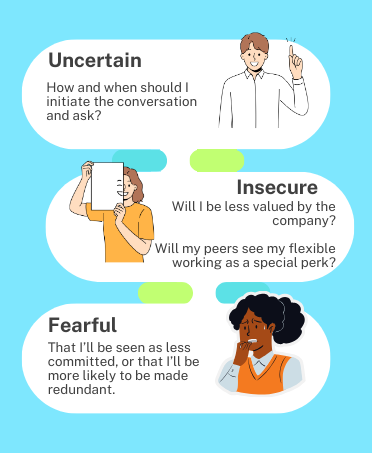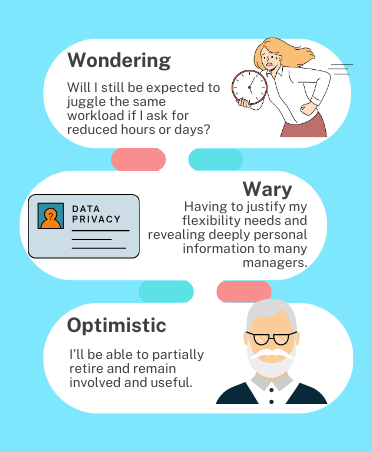Common feelings around asking for flexible working.






We understand how difficult it can be to ask for flexible working. The worry about job security, whether it will impact your career progression, whether your boss will question your committment, and how to even start the conversation.
You're not alone in feeling worried or uncertain.
They say a picture speaks a thousand words and that's where we hope MapMyFlex can help you.
MapMyFlex is designed to help you
The good news is there are a number of things you can do to be better prepared when you make the request.
Note that in 2024 the new Flexible Working bill was rolled out in the UK to help employees, making Flexible working requests easier and allowed as a day 1 request.
On this page we aim to provide some pointers and areas to think about. It is not written to be exhaustive and instead we provide links to established organisations which have in depth information on this subject matter.
Let's have a look at what you can do to help you with your flexible working request.
Flexible working is often seen as one dimensional and simply meaning working from home. The first step is to learn about the different types of flexible working, and work out which ones you would like or need. You can find more info here.
It's important to know that for many people a combination of different type of flex is required to allow them to remain in the workforce. This should not be viewed negatively, and is an opportunity for employers to be more inclusive by helping to hire/retain valuable employees.
Identifying what you want and where there is room to negotiate is key to ensuring that you can agree a flexible working schedule which works for you.
No.
With all the focus in recent years on remote working you'd be forgiven for thinking flexible working is one dimensional and simply means working from home.
There are at least 15 different flavours of flex, which revolve around three variables:
Our Flex Triangle illustrates this and you can find more info here.
It's important to think about what is a "must-have" for you, what is a "nice to have" and what doesn't impact you either way.
All are still valid when it comes to requesting flexible working and identifying these will help both you and your employer understand what is absolutely necessary for you to be able to work, and what would benefit the quality of your work / life balance.
Can you work regular office hours during the day, usually 9-5, or 9.30-5.30 ?
If not, would you be able to work with a flexible start and end time ie flexi time?
If you need to break up your working day, for example doing the school run, then would non-linear work hours work for you?
Would compressed hours be something that you’d like to free up time elsewhere?
We’re all very familiar by now with remote vs hybrid vs office based work.
Additional to this there is the question of how much travel a job may entail and how much travel you would like or be able to support.
For some people travel is a perk of the job whilst for others it can be inconvenient.
What could you compromise on?
Weight up the risks, the benefits and your goals.
The UK rolled out the new Flexible Working Bill on April 6th 2024. You can find more info here.
Key points from the Bill include:
There are many sources of information on your flexible working rights under current legislation and on the new Bill and what it means for you.
An excellent starting point is the ACAS site.
Also worth visiting are the CIPD and UK Government sites.
In July 2023, ACAS started a consultation to update its code of practice on handling flexible working requests, with an updated version published following the rollout of the Flexible Working Bill in the UK.
The new code of conduct aims to encourage a more positive approach to flexible working, and to reflect significant shifts in both ways of working and anticipated changes to the law.
The Government site is also a useful resource for information.
Does your company already embrace flexible working, what flexibility is currently available to people and does your company allow different types of flexible working already – not just remote?
What is the culture within your department and your team? Are there already successful examples of flexible working? If there are, great, and if not then don’t be disheartened, you could lead a way forward.
The Flexible Working Bill rolled out in 2024 this aims to help people when requesting flex. You no longer have to outline how your flexible working request affects the business.
You can make either a formal or an informal request for flexible working.
A formal request is one where you legally have the right to request flexible working.
An informal request is where you're not using the statutory procedure but would like to make the request anyway. This may be applicable if you don't have the statutory right to ask, or because you've already made 2 requests within 12 months, or it's a small change like meal-time flex, or if it's a short-term change in working conditions.
In both cases it is advised by various authorities on the matter to make the request in writing. See the Working Families for more guidance and information.
The following steps are involved in making a statutory request.
Set up a meeting with your manager in an environment where you’ll feel comfortable.
Whilst you shouldn’t have to consider when or where your manager may be most receptive, it’s human nature that these things can be important.
You don’t have to wait for your performance review or your objectives setting session with your manager.
Once you’ve done your preparation ask to have a chat and communicate clearly and concisely.
Whilst you aren’t required to outline the effect of your proposed flexible working change or how your employer could deal with it, it may help for you to propose your desired working schedule, and have a backup proposal ready too.
You could offer to trial the proposed flexibility changes and see which work well, or you could work with your employer over time to test out what works best.
As any good project manager knows, it’s important to consider communication channels and frequency to ensure everything progresses smoothly.
Changes to work schedules will take time to acclimatise to for you, your co-workers and your manager. Knowing when you and others will be available, and how, means everything can continue running smoothly.
Hopefully your employer will be receptive and support your flexible working request.
It is possible your manager may not approve the request and, should this happen, be mentally prepared to hear this.
Have a plan B, whether that is to accept the request denial and carry on, or to wait and try again at a later time.
Consider your options, whether you would like to find another employer who would support flexible working, whether you can afford to walk away or whether to stay on.
Whatever you decide, we wish you success.
Feel free to use MapMyFlex as
a visual aid to help with your request.